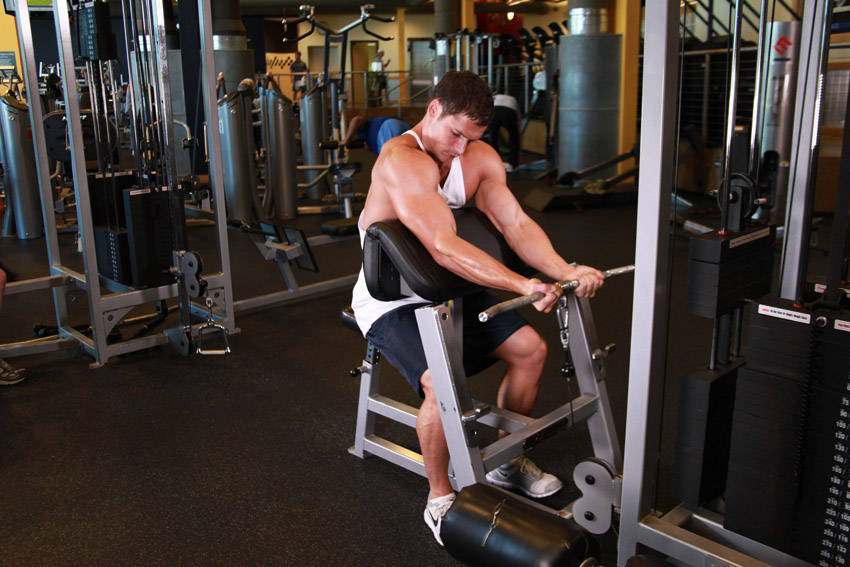Cable Bicep Curl is one of the most effective exercises for biceps because of multiple reasons. It is kind of an advanced version of traditional barbell curl and it helps you to put your biceps into more time under tension that activates your muscles for longer period of time and may lead to better results. Barbell curl is still one of the best exercises for biceps because of how heavy you can go with this exercise but we can’t ignore the effectiveness of cable bicep curl when it comes to create tension on the muscles in a constant manner.

Without further ado, let’s know how to perform cable bicep curl in proper form and technique so that you can get your dream biceps. Moreover, know about all the amazing benefits of this exercise in this same article. And, if you want to perform other variations of this exercise then here you can also find all the excellent variations that you can try for your convenience and faster progress. Let’s get started.
How to Perform Cable Bicep Curl?!
Here’s our step-by-step guide on how to do the Cable Bicep Curl properly without the risk of being injured.
1. Start by setting up the cable machine: Position yourself in front of a cable machine and adjust the pulley to the lowest position. Attach a straight bar or an EZ-bar to the cable.
2. Stand with your feet shoulder-width apart while facing the cable machine. Then, grab the bar with an underhand grip (palms facing upward) and hands also should be kept shoulder-width apart. Next, keep your elbows close to your torso throughout the exercise.
3. Position yourself at a sufficient distance from the cable machine so that your arms are fully extended, and there is tension in the cable. This will be your starting position.
4. Brace your core and maintain a straight posture throughout the exercise. Engage your biceps and prepare to initiate the movement.
5. Keeping your upper arms stationary, exhale and slowly curl the bar upward towards your shoulders. Focus on squeezing your biceps to lift the weight.
6. Continue the curling motion until your biceps are fully contracted and the bar is at shoulder level. Pause for a brief moment, feeling the contraction in your biceps.
7. Inhale and slowly lower the bar back to the starting position in a controlled manner, extending your arms fully. Maintain tension in the biceps as you lower the weight.
8. Repeat the movement for the desired number of repetitions. It’s recommended to start with a weight that allows you to perform 8-12 reps with proper form.
Master Your Form with These Tips!
– Avoid using momentum or swinging your body to lift the weight. Keep the movement controlled throughout the exercise.
– Focus on contracting your biceps and feeling the muscle working during each repetition.
– Keep your elbows stationary throughout the exercise. Avoid allowing them to flare out or move forward.
– Maintain a neutral spine and avoid arching your back excessively.
– Breathe naturally throughout the exercise, exhaling during the lifting phase and inhaling during the lowering phase.
– Start with a weight that challenges you but still allows you to maintain proper form. Gradually increase the weight as you become stronger and more comfortable with the exercise.

Remember, it’s always a good idea to consult with a qualified fitness professional before starting any new exercise program, especially if you’re a beginner or have any pre-existing medical conditions.
Benefits of Cable Bicep Curl
Performing this bicep movement can offer several benefits from developing a big and muscular set of biceps to improving grip strength. Here are the amazing benefits of Cable bicep curl that you should know!
Targeted Bicep Development
Cable bicep curls primarily target the biceps brachii, which is the main muscle responsible for flexing the elbow joint and creating the coveted “bicep peak.” By regularly performing this exercise, you can effectively stimulate and develop your biceps, leading to improved muscle strength and size.

Muscle Balance and Symmetry
The cable bicep curl helps to promote balanced arm development. Since each arm works independently during the exercise, any muscular imbalances between your left and right arm can be identified and addressed. This can lead to improved symmetry and aesthetics in your bicep muscles.
Functional Strength
Strong biceps are essential for many everyday activities and sports that involve pulling, lifting, and carrying. By strengthening your biceps through cable bicep curls, you enhance your ability to perform these tasks efficiently and with reduced risk of injury.

Improved Grip Strength
Cable bicep curls require you to maintain a firm grip on the bar throughout the movement. This helps develop and strengthen the muscles of your forearms, wrists, and hands, leading to improved grip strength. Enhanced grip strength can be beneficial in various activities such as weightlifting, sports, and even day-to-day tasks.

Muscle Engagement Variation
The cable bicep curl provides a different type of resistance compared to traditional dumbbell or barbell curls. The constant tension from the cable throughout the exercise ensures that your biceps are engaged during both the concentric (lifting) and eccentric (lowering) phases. This can enhance muscle activation and stimulate muscle growth effectively.
Joint Stability and Control
Cable exercises, including bicep curls, require you to stabilize your body and maintain control throughout the movement. This can help improve joint stability and control in the elbows, wrists, and shoulders. Strengthening these joint structures can lead to better overall joint health and reduced risk of injury.

Versatility and Adjustability
Cable machines often offer various attachments and adjustable settings, allowing you to modify the exercise and target different aspects of the bicep muscles. You can use different grip attachments, such as a straight bar, EZ-bar, or rope, to emphasize different parts of the biceps and forearm muscles.
Remember that to maximize the benefits of cable bicep curls, it’s important to maintain proper form, progressively increase the weight or resistance over time, and include them as part of a well-rounded workout routine that incorporates other exercises for balanced muscle development.
Variations of Cable Bicep Curl
There are several variations of the cable bicep curl exercise that you can include into your workout routine to add variety and target different aspects of the biceps and forearm muscles. Here are some common variations.
Straight Bar Cable Bicep Curl
This is the standard variation described earlier. You use a straight bar attachment on the cable machine, maintaining an underhand grip with hands shoulder-width apart. This variation primarily targets the overall bicep muscle.

EZ-Bar Cable Bicep Curl
Instead of a straight bar, you can use an EZ-bar attachment, which has a zigzag shape that provides a more ergonomic grip. The angled grip can be more comfortable for some individuals and may reduce strain on the wrists and forearms.
Rope Cable Bicep Curl
Attach a rope handle to the cable machine. Grasp the rope with an underhand grip, and instead of using a bar, curl the rope by flexing your elbows. This variation places more emphasis on the brachialis muscle, which is situated underneath the biceps, and can help create a more well-rounded appearance.
Reverse Grip Cable Bicep Curl
Instead of using an underhand grip, use an overhand grip (palms facing downward). This variation shifts the focus to the brachialis and brachioradialis muscles of the forearms, while still engaging the biceps. It can help improve forearm strength and size.

Single-Arm Cable Bicep Curl
Instead of using both arms simultaneously, perform the exercise one arm at a time. This variation allows for greater focus and isolation of each arm, helping to address any muscular imbalances. You can use a single handle attachment or hold onto the straight bar with one hand while keeping the other arm extended.
Preacher Cable Bicep Curl
Utilize a preacher curl attachment or a preacher bench with the cable machine. Set the bench at an angle, and while seated, position your arms on the pad. Perform the bicep curl while keeping your upper arms supported on the pad. This variation isolates the biceps even further by minimizing involvement of the shoulder muscles.

Isometric Hold Cable Bicep Curl
This variation involves performing a static hold at the midpoint of the curling motion. After curling the bar or attachment toward your shoulders, hold the position for a few seconds before slowly lowering it back down. Isometric holds increase time under tension and can enhance muscle strength and endurance.
When incorporating these variations, remember to adjust the cable machine, attachments, and weights to suit your needs and goals. It’s also essential to maintain proper form, focus on muscle engagement, and gradually increase the resistance over time to continue challenging your muscles and promoting growth. Be patient and stay consistent in your workout routine to get results as fast as possible. Hope, you have found this article about the technique, tips, benefits and variations of Cable bicep curl exercise helpful enough. If it’s really so then don’t hesitate to express your valuable thoughts in the comment section below. Thanks for visiting and appreciating our work.
